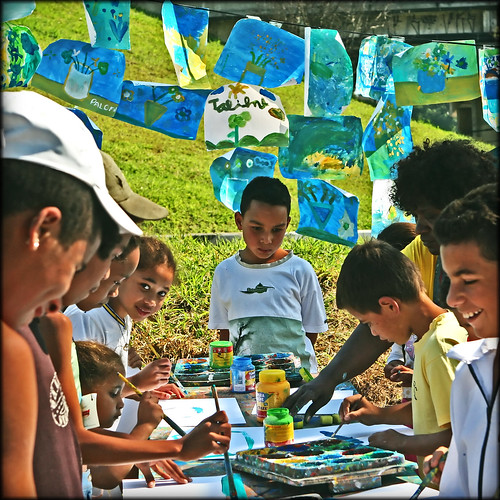 This is the seventh in a series of blog posts I wrote for Darren Sidnick. I am finally getting the rest of the series up. Part 1, part 2, part 3,, part 4, part 5, part 6, part 7 , part 8 , part 9 and part 1o are all here on the blog.)
This is the seventh in a series of blog posts I wrote for Darren Sidnick. I am finally getting the rest of the series up. Part 1, part 2, part 3,, part 4, part 5, part 6, part 7 , part 8 , part 9 and part 1o are all here on the blog.)
In the last post in this series we talked about some of the roles that support successful learning communities and CoPs (Communities of Practice). But when we think of these roles in the context of organizations like the e-learning provider UFI Learndirect (for whom this series was originally written), whose strength is providing learning services at a massive scale, some natural tensions are going to emerge. We might say “yeah, all these roles are nice, but there is no way to provide them a scale.”
How can we creatively thinking about scalability of roles? What might be the interaction between paid, formalized roles provided by Learndirect and the cultivation of roles within a learning cohort or an ongoing community? How might technology help us? Let’s look at some options.
- Within courses/intense support – assessment, content, and tutoring. Tutors with both content and pedagogical experience help students assess learning needs and pull together relevant resources (at Ufi learndirect, the pedagogy and much of the tutor support is in-built within the e-learning couse). They are a “first line” of support with explicit boundaries on what they can do. This may be more or less needed depending on the course. Some content lends itself to being a solo student experience with little support. Others are more complex and need more support. Technology may assist to direct relevant content to the right learners through diagnostic paths (a la Amazon’s recommendation system) on the assessment side.
 Across “course” offerings/building community support –community cultivation, connecting learners. While there might not be able to be an intense level of support at an individual cohort level, can there be learning communities that draw from multiple cohorts for the same course? For example, I may be taking a self paced module on childcare for infants. Within that course, there is no “community” per se, but I can log into the “Infant Childcare” community and ask questions of peers and experts, get access to more content and come back when I have questions about what I’ve learned in application. This might be seen as a set of domain specific portals. This offers the ability for both tutor and peer support on a more scalable level than at the course level (another way could be to take a generic course like numeracy or employability and build a niche community around say financial management that is a key issue for some of the learners. The same principle could work for leadership and management and many other more generi courses). All this can augment the automated diagnostics with a community of people who might have more diverse or contextual recommendations. Developing good critical thinking to evaluate and assess recommendations – automated or human, may be something important to foster within the community(ies.)
Across “course” offerings/building community support –community cultivation, connecting learners. While there might not be able to be an intense level of support at an individual cohort level, can there be learning communities that draw from multiple cohorts for the same course? For example, I may be taking a self paced module on childcare for infants. Within that course, there is no “community” per se, but I can log into the “Infant Childcare” community and ask questions of peers and experts, get access to more content and come back when I have questions about what I’ve learned in application. This might be seen as a set of domain specific portals. This offers the ability for both tutor and peer support on a more scalable level than at the course level (another way could be to take a generic course like numeracy or employability and build a niche community around say financial management that is a key issue for some of the learners. The same principle could work for leadership and management and many other more generi courses). All this can augment the automated diagnostics with a community of people who might have more diverse or contextual recommendations. Developing good critical thinking to evaluate and assess recommendations – automated or human, may be something important to foster within the community(ies.)- Learning support from the “wider world” – tapping into networks, professional associations and local organisations. An important learning bridge is that place between the formality of a “course” and the ongoing application of learning in the world. This ongoing learning is primarily informal. We can link students to external supports for their ongoing learning. It may be professional associations, guilds, communities of practice or local organizations. Linking learners to these ongoing support not only bridges to application, but it may also attract people from the community who wish to participate in domain communities sponsored by the learning institution, offering value in both directions.
The bottom line is that support roles are neither fixed, nor limited to paid, internal resources. If we look at the value chain across this ecosystem, each layer, each player has something to offer and something to gain through cooperating.
Resources:
- http://learningcircuits.blogspot.com/2006/06/roles-in-cops.html
- http://www.joe.org/joe/2008august/a1.shtml
Images:
 (I wrote this in January – never finished, nor published it. I’m cleaning out some blog drafts and it felt worthwhile to try and tidy this one up and get it out. )
(I wrote this in January – never finished, nor published it. I’m cleaning out some blog drafts and it felt worthwhile to try and tidy this one up and get it out. ) This is the sixth in a series of blog posts I wrote for
This is the sixth in a series of blog posts I wrote for  the creation of the course, then are essentially gone. A tutor (see next description) may take on this role. In many learning communities, the members themselves are to some extent or another, also experts. This means as a value we explicitly recognize, value and use the knowlege of the learners. This can lead to peer mentoring or peer tutoring. As humans too, we generally appreciate being recognized. So this build social capital in a learning group.
the creation of the course, then are essentially gone. A tutor (see next description) may take on this role. In many learning communities, the members themselves are to some extent or another, also experts. This means as a value we explicitly recognize, value and use the knowlege of the learners. This can lead to peer mentoring or peer tutoring. As humans too, we generally appreciate being recognized. So this build social capital in a learning group. Content scanners and filterers – we talk about information overload. These people see it as a candy store. They scan, notice and often love to share what they have found. Set up tools and places for these folks to bring in external resources into your course. We’ll talk more about the HOW of doing this in a subsequent blog post.
Content scanners and filterers – we talk about information overload. These people see it as a candy store. They scan, notice and often love to share what they have found. Set up tools and places for these folks to bring in external resources into your course. We’ll talk more about the HOW of doing this in a subsequent blog post. The word “tinkering” keeps coming up to my radar screen, and it makes me happy. I love the idea of tinkering and find it central to the practice of
The word “tinkering” keeps coming up to my radar screen, and it makes me happy. I love the idea of tinkering and find it central to the practice of  Alex Soojung-Kim Pang
Alex Soojung-Kim Pang 